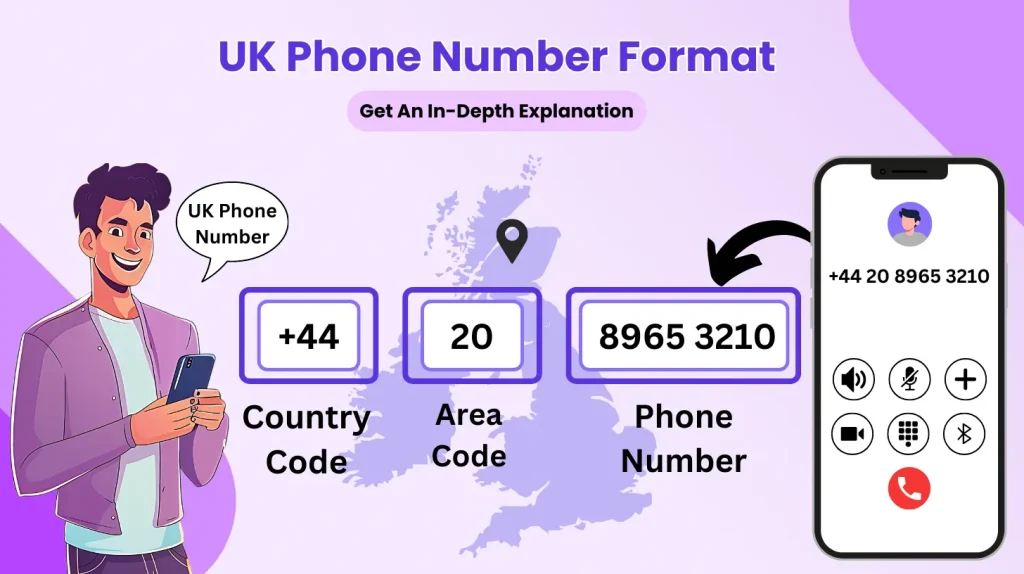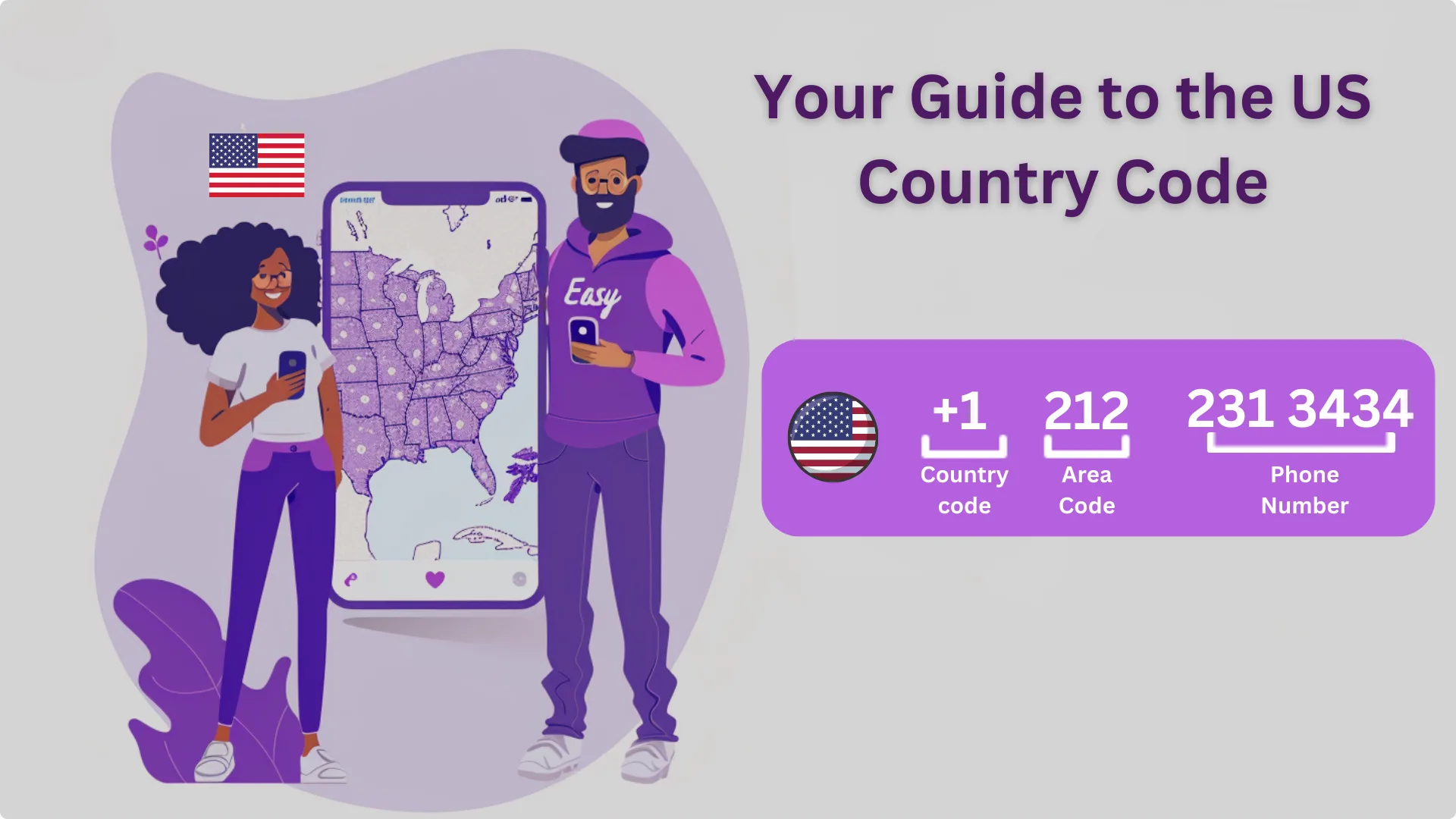In today’s globalized world, effective communication is the key to expanding your business and reaching new markets. If you’re looking to establish a presence in the United Kingdom, understanding the intricacies of UK phone numbers is essential. However, navigating the various formats, dialing codes, and area codes can be confusing, especially for international callers. This comprehensive guide aims to simplify UK phone numbers, providing you with the knowledge and confidence to make successful calls and foster seamless communication with your UK contacts.
Breaking Down the UK Phone Number Format
The Anatomy of a UK Phone Number
To grasp the structure of UK phone numbers, it’s essential to understand the E.164 standard, a globally recognized format for international telephone numbers established by the International Telecommunication Union (ITU). The E.164 standard ensures that phone numbers are compatible across different countries and telecommunication networks.
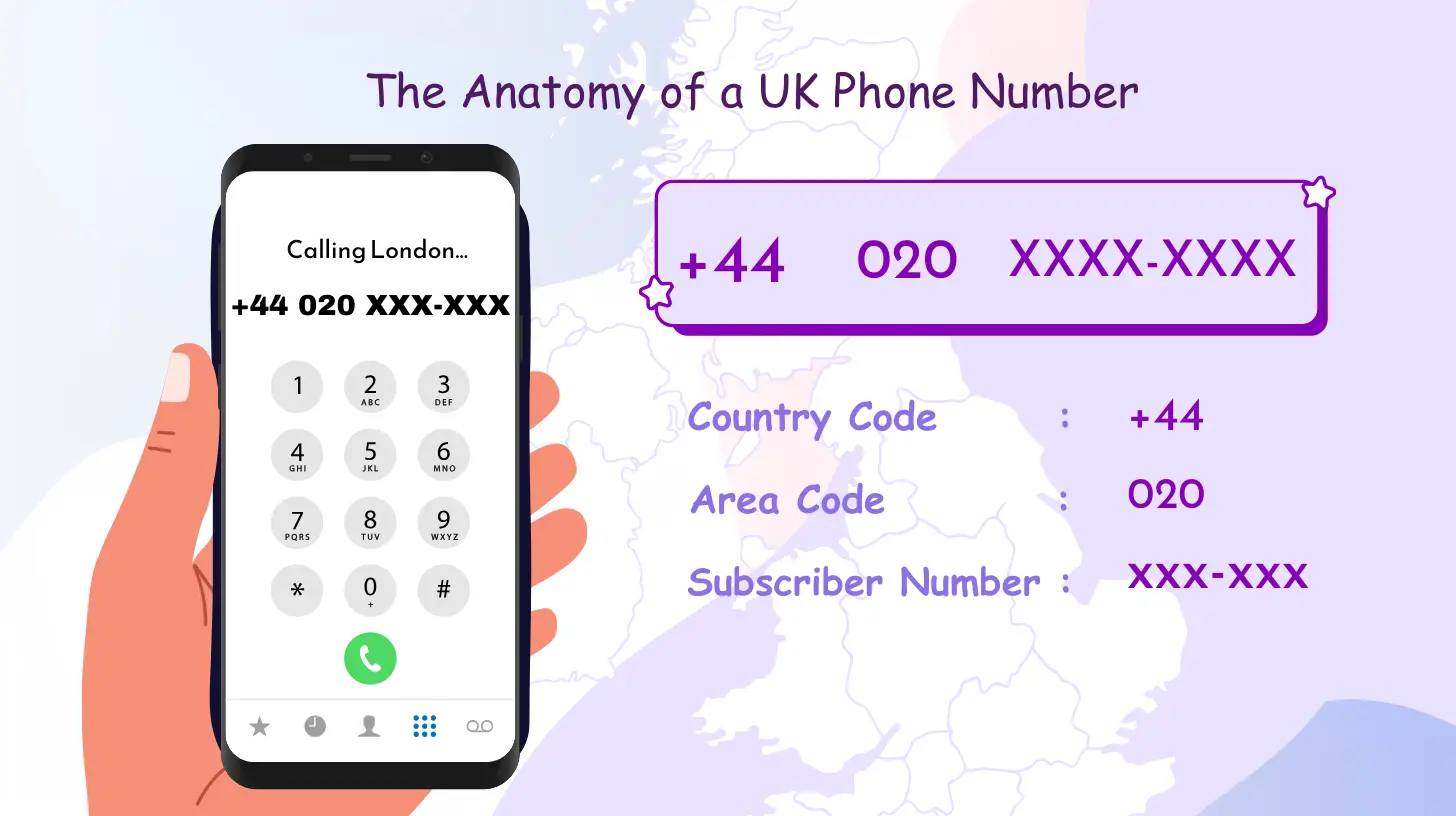
A UK phone number adhering to the E.164 standard consists of three main components:
- Country Code: The UK’s country code is +44. This code identifies the call as originating from outside the UK and is required when dialing from abroad. The plus sign (+) represents the international access code, which varies depending on the country you are calling from.
- Area Code: Following the country code is the area code, also known as the National Destination Code (NDC). Area codes in the UK can be 2, 3, 4, or 5 digits long and are assigned based on geographic location. For example, London’s code is 020, while Manchester’s is 0161. When dialing from within the UK, the leading 0 of the code is typically included.
- Subscriber Number: The subscriber number, also referred to as the local number, follows the area code. It is usually 4-8 digits long, depending on the length of the area code. Together, the regional code and subscriber number form the National Significant Number (NSN).
It’s important to note that the maximum length of a UK phone number, including the country code, is 15 digits. This limit ensures compatibility with international telecommunication systems and adherence to the E.164 standard.
By understanding the anatomy of a UK phone number and the E.164 standard, you’ll be better equipped to format and dial numbers correctly, whether you’re calling from within the UK or from abroad. In the following sections, we’ll delve into the various regional codes and dialing procedures to ensure your calls to the UK are successful.
Understanding UK Area Codes
Decoding UK Area Codes
UK area codes play a crucial role in the country’s telephone system, allowing calls to be routed to the correct geographic location. These codes vary in length and are assigned to different regions, cities, and towns throughout the United Kingdom.
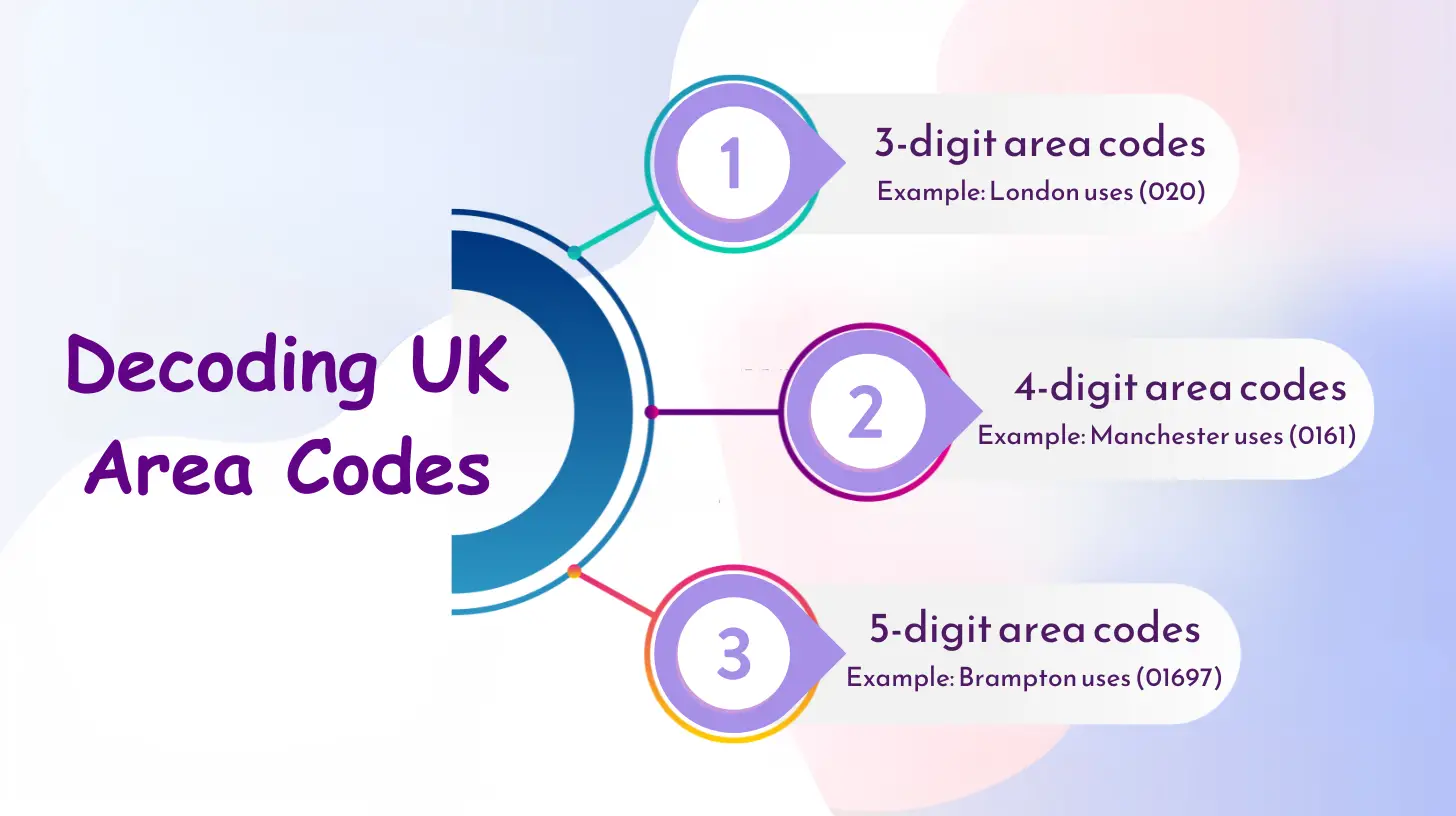
Area codes in the UK can be classified into three main types:
- 3-digit area codes: These locational prefixes are assigned to larger cities and densely populated areas. For example, London uses 020, while Birmingham’s is 0121.
- 4-digit codes: Most regional prefixes in the UK fall under this category. They are used for smaller cities, towns, and rural areas. Examples include 0161 for Manchester and 0141 for Glasgow.
- 5-digit codes: These longer prefixes are less common and are typically assigned to newer or smaller telephone exchange areas. An example is 01697 for Brampton, a small town in Cumbria.
Here are some examples of major UK cities and their corresponding area codes:
- London: 020
- Edinburgh: 0131
- Liverpool: 0151
- Leeds: 0113
- Cardiff: 029
- Belfast: 028
It’s worth noting that for the UK phone number format in some major cities like London, there are multiple regional prefixes due to their size and the need to accommodate a large number of phone numbers. In such cases, the locational code may be followed by a 3-digit identifier representing a specific borough or district within the city.
For a comprehensive list of UK prefixes and their corresponding locations, you can refer to the National Telephone Numbering Plan provided by Ofcom, the UK’s communications regulator. This resource offers an in-depth look at the allocation of these codes and is regularly updated to reflect any changes in the numbering system.
By familiarizing yourself with UK regional prefixes, you’ll be better prepared to identify the location of the person or business you’re trying to reach, and you’ll be able to format phone numbers correctly when dialing from within the UK or abroad.
Codes for Dialing UK Phone Numbers
In today’s globally connected world, making phone calls to the United Kingdom from abroad is a common occurrence. Whether you’re conducting business, staying in touch with friends and family, or planning a trip, it’s essential to understand the proper way to dial UK phone numbers from outside the country. In this section, we’ll cover the key concepts you need to know, including international access codes and how to format UK phone numbers correctly when dialing from abroad.
The Keys to Dialing Success
When placing a call to a UK phone number from outside the United Kingdom, it’s crucial to understand the role of international access codes and how to properly format the phone number. International access codes are the first digits you dial to initiate an international call, and they vary depending on the country you’re calling from.
The most common international access codes are:
- 00: Used by most European countries and many others worldwide
- 011: Used primarily in the United States and Canada
- +: The plus sign can be used universally on mobile phones to automatically insert the appropriate international access code
To illustrate, let’s say you’re calling a UK number from the United States. The UK country code is 44. So, you would dial:
011 (US international access code) + 44 (UK country code) + the rest of the number
It’s important to note that when dialing a UK number from abroad, you must drop the leading ‘0’ from the area code. In the UK, area codes typically begin with a ‘0’ when dialing domestically. However, this ‘0’ is not part of the international format and must be omitted when calling from outside the UK.
For example, to call a London number from abroad, you would dial:
[International access code] + 44 (UK country code) + 20 (London area code without the leading ‘0’) + the local number
So, if the London number is 020 1234 5678, you would dial:
011 44 20 1234 5678 (from the US)
00 44 20 1234 5678 (from most other countries)
+44 20 1234 5678 (from a mobile phone)
Remember, the format is:
[International access code] + [Country code] + [Area code without ‘0’] + [Local number]
By understanding international access codes and correctly formatting the phone number, you can ensure that your calls to the UK go through smoothly, avoiding any confusion or connection issues.
How To Call A UK Phone Number?
Calling a UK phone number may seem like a straightforward task, but there are a few important factors to consider, depending on whether you’re making a domestic or international call, and whether you’re calling a landline or a mobile phone. In this section, we’ll break down the process into simple, easy-to-follow steps, ensuring that you can successfully connect with anyone in the United Kingdom, regardless of your location.
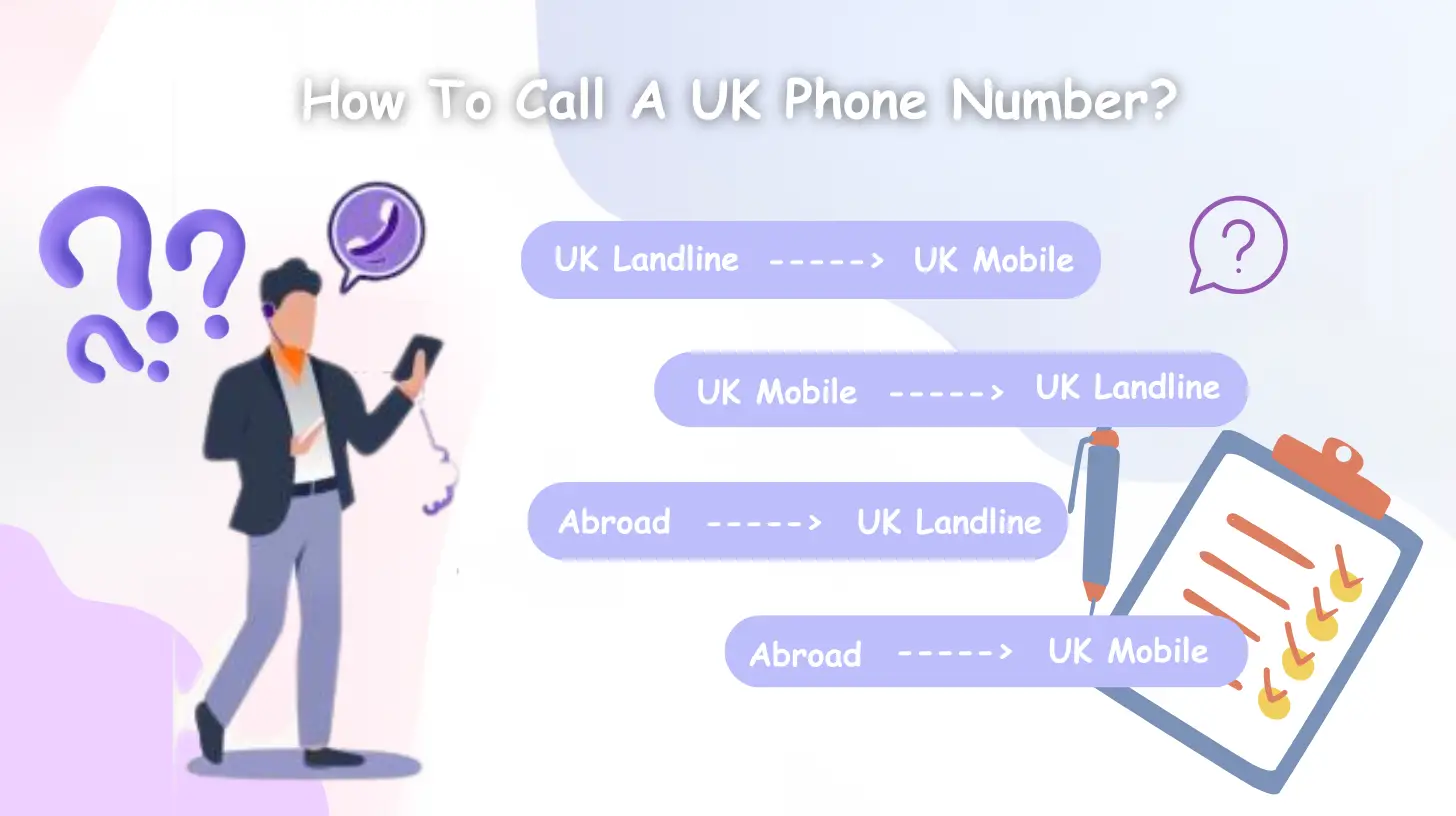
Step-by-Step to Connection
Calling a UK phone number can seem daunting, especially if you’re unsure about the proper format or access codes. In this section, we’ll provide clear, step-by-step instructions for making both domestic and international calls to UK landlines and mobile phones.
Domestic Calls:
When calling from within the UK, the process is relatively simple:
For landlines:
- Dial the full area code (including the leading ‘0’)
- Dial the local number
For example, to call a London landline from within the UK: 020 1234 5678
For mobile phones:
- Dial the mobile number (starting with ’07’)
UK mobile numbers don’t have area codes, so you always dial the full 11-digit number.
Note: If you’re calling from a landline to a number within the same area code, you can often omit the area code and simply dial the local number.
International Calls:
When calling a UK number from abroad, the process is slightly different for landlines and mobile phones:
For landlines:
- Dial the international access code (011 from the US, 00 from most other countries, or + from a mobile phone)
- Dial 44 (the UK country code)
- Dial the area code (without the leading ‘0’)
- Dial the local number
For example, to call a London landline from the US: 011 44 20 1234 5678
For mobile phones:
- Dial the international access code
- Dial 44 (the UK country code)
- Dial the mobile number (without the leading ‘0’)
For example, to call a UK mobile from the US: 011 44 7123 456789
Dialing Variations Table:
| Origin | Destination | Format |
|---|---|---|
| UK Landline | UK Landline | [Area Code (with ‘0’)] + [Local Number] |
| UK Landline | UK Mobile | 07 + [Mobile Number] |
| UK Mobile | UK Landline | [Area Code (with ‘0’)] + [Local Number] |
| UK Mobile | UK Mobile | 07 + [Mobile Number] |
| Abroad | UK Landline | [Int’l Access Code] + 44 + [Area Code (no ‘0’)] + [Local Number] |
| Abroad | UK Mobile | [Int’l Access Code] + 44 + [Mobile Number (no ‘0’)] |
By following these step-by-step instructions and referring to the dialing variations table, you should be able to confidently call any UK phone number, whether you’re within the UK or abroad.
Examples of UK Phone Numbers
To help illustrate the concepts we’ve discussed so far, let’s take a look at some real-world examples of UK phone numbers in both their domestic and international formats. By seeing how these numbers are properly written and dialed, you’ll be better prepared to make calls to the UK with confidence, whether you’re calling from within the country or from abroad.
See It in Action
Now that we’ve covered the basics of UK phone number formats and how to dial them, let’s take a look at some concrete examples. Seeing the proper formatting in action can help solidify your understanding and give you a clear reference point for future calls.
UK Landline Numbers:
Domestic Format:
- 020 1234 5678 (London)
- 0161 123 4567 (Manchester)
- 0131 123 4567 (Edinburgh)
International Format:
- +44 20 1234 5678 (London)
- +44 161 123 4567 (Manchester)
- +44 131 123 4567 (Edinburgh)
Remember, when dialing a UK landline from abroad, you need to drop the leading ‘0’ from the area code.
UK Mobile Numbers:
Domestic Format:
- 07123 456789
- 07987 654321
- 07555 123456
International Format:
- +44 7123 456789
- +44 7987 654321
- +44 7555 123456
UK mobile numbers always start with ’07’ and do not have an area code. When dialing from abroad, simply drop the ‘0’ and replace it with the UK country code (+44).
It’s worth noting that UK phone numbers can be written in a variety of formats, such as:
- 020 1234 5678
- (020) 1234 5678
- 020-1234-5678
- 020.1234.5678
However, when dialing, you should always input the number using only digits, without any punctuation or spaces.
By familiarizing yourself with these examples and understanding the proper formatting for both domestic and international calls, you’ll be well-equipped to connect with anyone in the United Kingdom, whether you’re calling a landline or a mobile phone.
Types of UK Phone Numbers
While landlines and mobile phones are the most common types of phone numbers in the UK, several other categories of numbers serve specific purposes within the telephone system. In this section, we’ll explore the differences between geographic landline numbers, mobile numbers, and non-geographic numbers, providing you with a more comprehensive understanding of the UK’s telephony landscape.
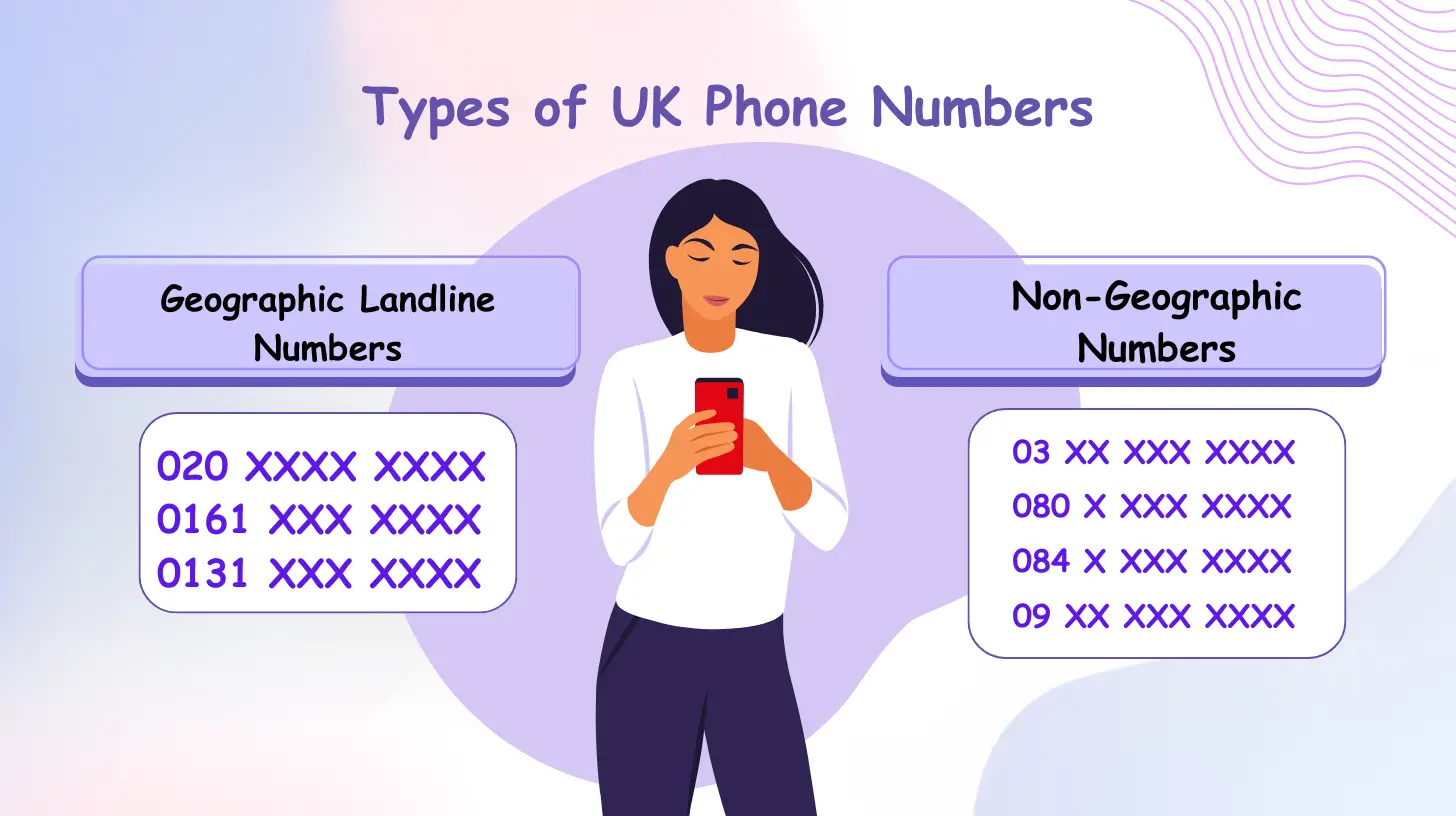
Beyond the Basics
While most people are familiar with the basic concepts of landlines and mobile phones, the UK telephone system incorporates several other types of numbers that serve specific purposes. Understanding the differences between these number types can help you navigate the system more effectively and avoid any confusion when making or receiving calls.
Geographic Landline Numbers:
Geographic landline numbers are tied to specific area codes and are associated with a particular location within the UK. These numbers typically start with ’01’ or ’02’, followed by the area code and the local number. For example:
- 020 xxxx xxxx (London)
- 0161 xxx xxxx (Manchester)
- 0131 xxx xxxx (Edinburgh)
When calling a geographic landline number from within the same area code, you can usually omit the area code and simply dial the local number.
Mobile Numbers:
UK mobile numbers always start with ’07’ and are not tied to any specific geographic location. These numbers are assigned to individual mobile devices and can be used anywhere within the UK’s mobile network coverage area. For example:
- 07xxx xxxxxx
Mobile numbers in the UK are 11 digits long (including the ’07’ prefix) and do not require an area code when dialing from within the country.
Non-Geographic Numbers:
In addition to geographic landlines and mobile numbers, the UK also uses non-geographic numbers for various purposes. These numbers start with ’03’, ’08’, or ’09’ and are not linked to a specific location. Some common types of non-geographic numbers include:
- 03xx xxx xxxx: Used for customer service lines, charities, and other organizations. Calls to these numbers cost the same as calls to geographic landlines.
- 080x xxx xxxx: Used for freephone services, where the call recipient pays for the call. These numbers are often used by businesses for customer support or sales inquiries.
- 084x xxx xxxx or 087x xxx xxxx: Used for service numbers, where the caller pays a higher rate to access a particular service, such as technical support or entertainment lines.
- 09xx xxx xxxx: Used for premium rate services, where the caller pays a significantly higher per-minute rate for access to specialized content or services.
When calling non-geographic numbers from abroad, you should include the UK country code (+44) and omit the leading ‘0’ from the number, just as you would with geographic landlines and mobile numbers.
By familiarizing yourself with these different types of UK phone numbers and their associated formats, you’ll be better equipped to make and receive calls efficiently, whether you’re dealing with a standard landline, a mobile number, or a specialized non-geographic service.
UK Phone Numbers: Best Practices
When calling UK phone numbers from abroad, it’s essential to understand the different formats and include the appropriate regional prefixes. UK landline numbers typically consist of a locational prefix followed by a 7-digit subscriber number, while mobile numbers usually start with 07 followed by a 9-digit number.
When making calls to UK mobile phones from another country, it’s necessary to include the country code (44) and the mobile prefix (07), omitting the initial zero. For example, to call a UK mobile number from the United States, you would dial +44 7XXX XXXXXX.
Additionally, the UK has several non-geographic numbers starting with 03, 08, and other prefixes. These numbers are often used for various purposes, such as customer service, sales, and other business functions. It’s essential to be aware of the charges associated with calling these non-geographic numbers, as they may differ from standard landline or mobile rates.
Another crucial factor to consider when calling the UK is the time zone difference. The UK operates on British Summer Time (BST) from late March to late October, which is one hour ahead of Coordinated Universal Time (UTC). During the rest of the year, the UK follows Greenwich Mean Time (GMT), which is the same as UTC. Ensuring you call during appropriate hours can increase the chances of successful communication.
For those travelling or calling from different countries, it’s advisable to check the international dialing codes for the specific country you’re calling from. Resources like the International Telecommunication Union’s (ITU) country code list can provide up-to-date information on dialing codes for various countries.
By understanding the different UK phone number formats, area codes, non-geographic numbers, time zone differences, and international dialing codes, you can ensure a smoother and more successful calling experience when contacting individuals or businesses in the United Kingdom using the proper format phone number.
UK Phone Numbers & VoIP Solutions
In the rapidly evolving world of telecommunications, businesses and individuals are constantly seeking ways to improve their communication capabilities while reducing costs. One technology that has gained significant traction in recent years is Voice over Internet Protocol (VoIP), which offers a compelling alternative to traditional phone systems. In this section, we’ll explore how VoIP solutions can benefit those looking to optimize their UK communications, highlighting key advantages such as cost savings, flexibility, and advanced features.
The Benefits of VoIP for UK Communications
In recent years, Voice over Internet Protocol (VoIP) has emerged as a powerful and flexible alternative to traditional phone lines. VoIP technology allows users to make and receive phone calls using an internet connection instead of a standard telephone network. This innovative approach to telephony offers numerous benefits, particularly for businesses and individuals looking to optimize their UK communications.
One of the most significant advantages of VoIP is cost savings. By routing calls through the internet, VoIP providers can offer more affordable rates compared to traditional phone services, especially for international calls. This can lead to substantial savings for businesses with a large volume of UK-based customers or partners.
In addition to cost savings, VoIP solutions offer unparalleled flexibility. With VoIP, users can make and receive calls from anywhere with a stable internet connection, using a variety of devices, such as smartphones, tablets, or laptops. This flexibility enables remote work, seamless office transitions, and the ability to stay connected while traveling.
VoIP systems also come with a wide range of advanced features that can enhance your UK communications. These features include:
- Call forwarding: Automatically redirect calls to another number or device, ensuring you never miss an important call.
- Virtual numbers: Obtain UK phone numbers without needing a physical presence in the country, allowing international businesses to establish a local presence.
- Voicemail-to-email: Receive voicemail messages as email attachments, making it easy to listen to and manage your messages from any device.
- Call recording: Record calls for training, quality assurance, or legal purposes, with easy access to the recordings through your VoIP portal.
For international businesses looking to establish a presence in the UK market, VoIP solutions can greatly simplify the process of obtaining UK phone numbers. Many VoIP providers offer virtual UK numbers that can be assigned to your account, allowing you to create a local point of contact for your UK customers without the need for a physical office or traditional phone line in the country.
By leveraging VoIP technology, businesses and individuals can not only reduce their communication costs but also enjoy a wide range of features and benefits that can enhance their UK telephony experience. As the world becomes increasingly connected and remote work continues to grow in popularity, VoIP solutions are poised to play an even greater role in shaping the future of UK communications.
UK Phone Number Glossary
Throughout this comprehensive guide, we’ve explored various aspects of UK phone numbers, from formatting and dialing procedures to the different types of numbers and the benefits of VoIP solutions. To ensure that you have a clear understanding of the key concepts discussed, we’ve compiled a glossary of essential terms that you’ll encounter when dealing with UK telecommunications.
Key Terms Explained
Throughout this guide, we’ve used various terms related to UK phone numbers and the telecommunications industry. To help you better understand these concepts, we’ve compiled a short glossary defining the most essential terms:
- Area Code
- A regional prefix is a set of digits that identifies a specific geographic region within a country. In the UK, these prefixes are usually 2-5 digits long and precede the subscriber number for landline phone numbers.
- Country Code
- A country code is a unique numerical prefix that identifies a specific country or region. The UK’s country code is 44, which must be dialed before the locational prefix and subscriber number when making international calls to the UK.
- Subscriber Number
- The subscriber number, also known as the line or local number, is the set of digits assigned to an individual phone line or mobile device. In the UK, landline subscriber numbers are typically 7 digits long, while mobile numbers are 9 or 10 digits long.
- International Dialing Code
- The international dialing code is the prefix used to signal an international call. It is typically 00 or + (plus sign) and must be dialed before the country code when making international calls.
- Non-Geographic Number
- Non-geographic numbers are special phone numbers that are not tied to a specific geographic location. In the UK, these numbers often start with prefixes like 03, 08, or other combinations, and are used for various purposes, such as customer service, sales, or other business functions.
- VoIP (Voice over Internet Protocol)
- VoIP is a technology that enables voice communication over the Internet instead of traditional phone lines. It offers cost savings, flexibility, and advanced features like call forwarding and virtual numbers.
- SIP (Session Initiation Protocol)
- SIP is a communication protocol used in VoIP systems to initiate, manage, and terminate multimedia communication sessions, including voice and video calls.
- Virtual Number
- A virtual number is a telephone number that is not directly associated with a physical phone line or device. Virtual numbers can be used to route calls to different destinations, enabling features like call forwarding and remote call handling.
By understanding these key terms, readers can better navigate the world of UK phone numbers, international calling, and VoIP solutions, enabling more effective communication and business operations.
Troubleshooting UK Calling Issues
While this guide has provided you with a solid foundation for understanding and using UK phone numbers, there may still be times when you encounter issues when trying to connect with numbers in the United Kingdom. In this final section, we’ll explore some common problems that can arise, offer troubleshooting tips to help you overcome these challenges, and suggest reliable resources for finding further assistance if needed.
When Calls Don’t Go Through
Even with a clear understanding of UK phone number formats and dialing procedures, you may occasionally run into problems when trying to connect with numbers in the United Kingdom. Some common issues include:
- Incorrect number format: One of the most frequent reasons for failed calls is using the wrong number format. Double-check that you’ve included the correct international dialing code, country code, and area code (if applicable), and that you’ve omitted the leading ‘0’ when dialing from abroad.
- Blocked calls: In some cases, the recipient may have blocked calls from unknown or international numbers. If you suspect this might be the issue, try contacting the person through alternative means (such as email) to request that they unblock your number.
- International calling restrictions: Your phone plan may not include international calling, or you may need to activate this feature separately. Contact your service provider to inquire about your international calling options and any associated fees.
- Network issues: Occasionally, technical problems with your carrier or the recipient’s network can prevent calls from going through. If you consistently experience issues with a particular number, try calling from a different phone or network to determine if the problem lies with your service provider.
- Time differences: Keep in mind that the UK operates on Greenwich Mean Time (GMT) or British Summer Time (BST), depending on the time of year. Make sure you’re calling at an appropriate time, considering the time difference between your location and the UK.
If you’ve double-checked the number format, confirmed that you have international calling enabled, and ruled out network issues, but you’re still unable to connect with a UK phone number, there are several resources you can turn to for further assistance:
- Contact your service provider’s customer support for help with international calling issues or to report potential network problems.
- Consult online forums or social media groups dedicated to international calling or UK telecommunications for advice from experienced users.
- Reach out to the UK recipient through alternative channels (email, social media, or messaging apps) to confirm the correct phone number and any preferences they may have for receiving calls.
By understanding common issues and knowing where to find additional support, you can minimize the frustration of encountering problems when calling UK phone numbers and focus on maintaining strong connections with your contacts in the United Kingdom.
Conclusion
Navigating the intricacies of UK phone numbers and dialing procedures is crucial for effective communication with UK-based clients, colleagues, or contacts. This comprehensive guide has covered the essential elements, including area code formats, country codes, subscriber numbers, and international dialing protocols specific to the UK.
Understanding these nuances, including the proper UK phone number format, not only ensures successful call connections but also demonstrates professionalism and attention to detail, which can be invaluable in business relationships. Whether you’re an individual or a company operating internationally, mastering the UK phone number conventions and format can streamline communication and enhance your overall customer experience.
As a final tip, consider exploring VoIP (Voice over Internet Protocol) solutions, which can simplify the process of obtaining UK phone numbers and offer cost-effective, feature-rich communication options for businesses. VoIP systems often provide virtual UK numbers, call forwarding, and advanced calling features, enabling seamless integration with your existing operations.
We encourage readers to bookmark this guide as a valuable reference and share it with colleagues or team members who frequently communicate with UK-based entities. Stay informed, stay connected, and leverage the knowledge shared here to elevate your international calling experience.
FAQ's
The international format for UK phone numbers follows the E.164 standard, which includes the country code (44), area code, and subscriber number. For example, to call a London landline from abroad, you would dial +44 20 XXXX XXXX.
To validate a UK number, ensure it follows the correct format: country code (44), regional prefix (2-5 digits), and subscriber number (4-8 digits for landlines, 9-10 digits for mobiles). Also, check if the locational prefix corresponds to a valid UK region.
Within the UK, the standard local formatting for landline numbers includes the regional prefix and subscriber number (e.g., 020 XXXX XXXX for London). For mobile phone numbers, the format is simply the full 11-digit number, starting with 07.
UK mobile phone numbers always start with 07 and are 11 digits long, while landline numbers have varying regional prefixes and subscriber number lengths. If the number starts with 07, it’s a mobile/cell phone number.
To call a UK mobile phone number from abroad, dial the international call prefix (e.g., 00 or +), followed by the UK country code (44), then the mobile number without the leading 0 (e.g., +44 7XXX XXXXXX).
The dialing code or country code for the UK is 44. This code must be dialed when making international calls to the UK from other countries.
To format a UK telephone number for international calls, start with the international call prefix (00 or +), then the UK country code (44), followed by the regional prefix without the leading 0, and finally the subscriber number.
No, UK mobile phone numbers are not tied to a specific geographic region. Unlike landline numbers, mobile numbers can be used anywhere within the UK.
UK landline numbers have varying regional prefixes and subscriber number lengths, while mobile numbers always start with 07 and are 11 digits long. Landline numbers are tied to a specific geographic location, while mobile numbers can be used anywhere.
One option is to consider a VoIP (Voice over Internet Protocol) solution, which can simplify the process of obtaining UK geographic or non-geographic phone numbers for your international business. Many VoIP providers offer virtual UK numbers and advanced calling features.

